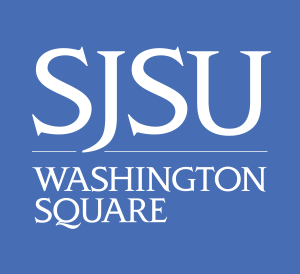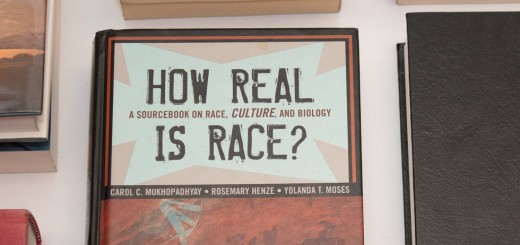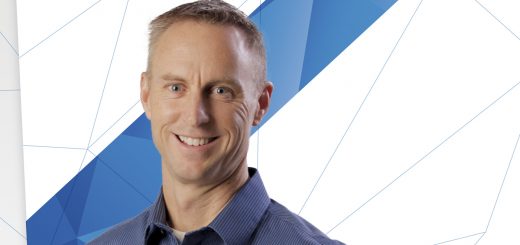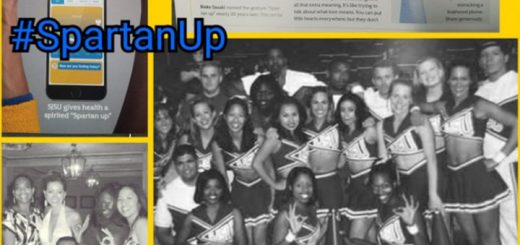Geology from the Ground Up

Jaime Alcala, ’19 Geology; Hollianne McClure, ’20 Geology; Alianora Walker, ’20 MS Geology; SJSU Geology Professor Manny Gabet; and ranger Rob Cala of San Mateo County Parks’ Fitzgerald Marine Preserve examine a site at the San Gregario fault at Pillar Point Bluff, Calif. Photo courtesy of Kim Blisniuk.
Rocks tell stories. Their age, their chemical composition, their placement in the environment, the manner in which they shift or move over time—geology offers insight into Earth’s history if a scientist knows where to look and which questions to ask, says Kim Blisniuk, assistant professor of geology. By understanding when and how land forms shift, fracture and change over time, she can gather data that helps evaluate earthquake hazard—data that may someday help keep communities safe.
“The rate at which a fault moves—how fast it moves—is proportional to the seismic hazard potential on a fault,” Blisniuk says. “The faster the fault moves, the higher the risk and the higher the hazard. Many landforms preserved on the Earth’s surface can be dated. By knowing the amount of movement the land form has recorded on the surface of the Earth, I can date it, and as a result I can get a rate at which that fault has moved over time. Measuring land movement and age is critical for estimating when earthquakes might recur.”
How do geologists measure seismicity and communicate earthquake risk to the communities that could one day be affected? First, Blisniuk says it’s essential for scientists to observe the natural world. Once rock samples are collected, they can be dated using geochronological tools, which reveal the rock’s mineral makeup. By decoding a rock’s chemical properties and history of movement, geologists not only contribute to scientific discoveries, but their data informs how architects, engineers and city planners build safe communities.
Location, Location, Location
Uniquely located between the San Andreas, Hayward and Calaveras faults, San Jose State is an appropriate place to study faults, says Blisniuk. Since the San Francisco Bay Area is vulnerable to seismic shifts, it is especially important that citizens as well as scientists be prepared for emergencies. Because Silicon Valley has one of the hottest development markets nationwide, it is increasingly important that builders, architects, city planners, homebuyers and property managers plan with geological data in mind. According to the city of San Jose’s “Development Highlights and Five-Year Forecast (2019-2023),” during the 2016-2017 fiscal year commercial construction in San Jose was valued at $399 million, a 16-year high. Thus the stakes are great, both economically and in terms of keeping people safe.
“STEM education matters because this is how we gather information—by understanding the research that came before, examining, testing and questioning it.”
—Kim Blisniuk
Kelly Dustin, ’11 BS, ’15 MS Geology, is an engineering geologist at Cleary Consultants and a self-described “earth detective” who analyzes soil, rock and land for Bay Area builders constructing commercial, private and public structures. Before a building can be built or remodeled, she says it is critical that geologists identify soil composition to determine its properties and translate that data into safe building practices, including how to build for future seismic activity. Some of these tests help geologists quantify if soil is vulnerable to liquefaction, a process by which waterlogged soils at or near the ground surface lose their strength and flow like liquid during an earthquake. When this happens, structures can shift and/or collapse while the earth flows below.
“We do tests to see how strong the soil is,” says Dustin. “How much will the soil shrink? How much will it swell? The answers give us clues as to how a project needs to be constructed. We have to look at the hazards associated with area. The research into seismicity done by the U.S. Geological Survey, private labs and universities like San Jose State leads to making building codes safer, which is a great way for academia to translate into the work we do.”
Dustin says the five summers she spent conducting geological research in northern Washington between her undergraduate and graduate years at San Jose State provided critical training for her career. Initially she accompanied SJSU Geology Professor Robert Miller to the Cascades to collect samples for his research. As she developed her senior thesis, she focused on plutons, rocks that are crystallized from a cooling magma chamber below the Earth’s surface. Through collaborations with researchers at the Massachusetts Institute of Technology and Oregon State University, Dustin got help dating rock samples and analyzing their geochemistry. She loved experiencing geology in the field and learning from fellow scientists.
“Field work shows future employers that you are capable,” Dustin says. “This translates really well into jobs. We go to professional meetings to present our research, which shows we can share our work with scientists, clients, customers and people who don’t speak ‘geology’ to make them feel comfortable and confident.”
The interaction Dustin describes—explaining why it’s important to consider geology when building, and how engineers and builders may need to adjust client expectations to make buildings safer—may appear simple, but it is a negotiation that many prospective homebuyers do not understand or are often not ready to accept. Additional examination of soils, an important safety measure that may not be visible to an untrained eye, often comes at a high cost. If a homeowner does not anticipate spending an additional $50,000 or more to retrofit or make a building seismically sound, the cost can feel shocking. Despite the likelihood that another large earthquake will hit the Bay Area, it is impossible to predict exactly when and where it will happen. This uncertainty creates doubt in the homeowners’ mind, especially if they are not informed on seismic risk. Dustin says that’s why it is critical that geologists, city officials and builders work together to evaluate risk and communicate accordingly.
The Influence of Social Pressure

High school intern Dennis Woo works with SJSU volunteer and Open University student Hudson Washburn at the San Gregorio fault at Pillar Point Bluff, Calif. Photo courtesy of Kim Blisniuk.
There is a science to communicating risk, says geologist Anne Sanquini, ’10 MS Geology, who is on the board of GeoHazards International, a nonprofit that partners with engineers, scientists, government officials, universities and community leaders in areas around the world that are prone to natural disaster. While completing her PhD at Stanford, she researched earthquake risk in the Kathmandu Valley in Nepal. Sanquini learned the region was susceptible to dangerous landslides and earthquakes, and yet little was being done to address the risk.
“Using available information, we quantified their hazard and risk in terms of floods, landslides and earthquakes, and tried to understand what the impact would be on buildings, people and infrastructure,” says Sanquini. “Even though we could clearly see from the geology and the built environment what the hazards and risks were, it was extremely difficult to get people to change from their current practices to be safe.”
Sanquini and her partners focused on retrofitting schools because their structures often house the most vulnerable populations and are used as emergency shelters. She came across an especially relevant scientific paper that analyzed how to prepare people for disaster. The findings concluded that people who were adequately prepared met three criteria: they knew what to do, they believed it would probably work, and they knew others who had taken steps to prepare. The “most powerful” motivator to inspire action? Social cues that supported taking precautions.
“How could we get them to improve their buildings?” Sanquini asks. “We visited five schools that had already taken action, thanks to local leadership from the National Society for Earthquake Technology (NSET) and made a film featuring those teachers, principals, parents and neighbors. We tested the film in a randomized controlled trial, similar to how you test a new drug, to see the degree to which seeing the research film versus seeing a placebo film would move the needle for those factors that would motivate action.”
“Knowing what to do and how to prepare for a disaster may one day save lives—your life and others—during an earthquake.”
—Kim Blisniuk
The trial was conducted over a year. On April 25, 2015, during her final trip, Sanquini was presenting her research to community members. She was also making plans with the Nepal Department of Education to expand the film to school communities outside the Kathmandu Valley area when a magnitude-7.8 earthquake hit, glass crashing and buildings groaning as she and her colleagues sought cover. The results were catastrophic: not only were 600,000 structures in Kathmandu and nearby towns damaged or destroyed, but 9,000 people were killed, with many thousands more injured. Sanquini and her colleagues survived unscathed and the retrofitted schools featured in the film also stood strong.
In 2016, Sanquini and her colleagues published three peer-reviewed articles on her research and she joined GeoHazards International. The nonprofit currently works in Nepal, Bhutan, India and Haiti to prepare communities for disaster, including earthquakes, landslides and tsunamis. Sanquini has traveled to several of their work sites for program evaluation.
“Natural hazards like earthquakes become disasters when people are not prepared,” Sanquini says. “To reduce harm, people must understand where they are living and the practical steps they can take to prepare. When they receive social cues from others, ideally peers taking action, this helps the entire community to move forward.”
Rock On
Blisniuk, like Sanquini, is hopeful that one need not survive a massive earthquake to understand the impact of geology. As a geology professor at SJSU and a research scientist for the Lawrence Livermore National Laboratory, Blisniuk has access to state-of-the-art technology to analyze geological samples. The recipient of a National Science Foundation Early Career Investigator grant, she plans to create the Promoting Undergraduate Research Experiences (PURE) program at SJSU, a paid internship for undergraduate geology majors to learn from the best resources across the Bay Area. Blisniuk wants to offer hands-on experiences and is especially focused on creating opportunities for women and underrepresented minority students.
Ultimately, she says, it’s important to listen to the stories that rocks tell and the role that people play in preparing for and responding to natural disaster. As a professor and researcher, Blisniuk is preparing the next generation of geologists to gather, challenge and analyze the data that could one day keep communities safe.




